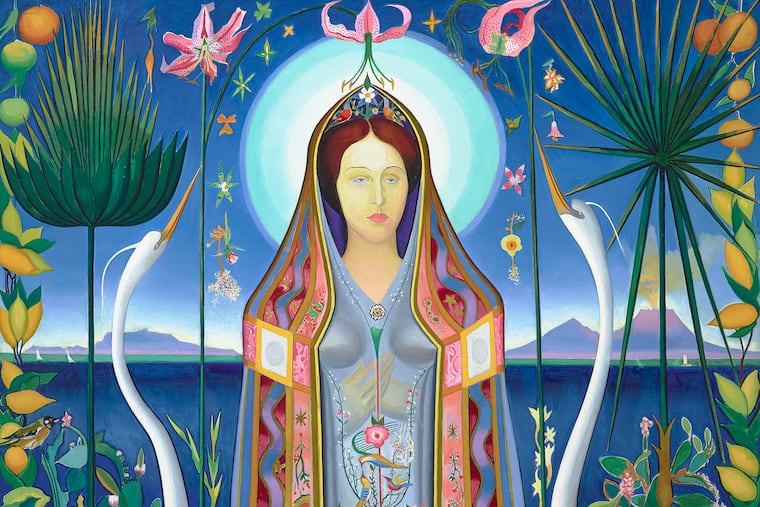Joseph Stella, the artist who drew industrial America, documented Pittsburgh society & nature for years
Brandywine Museum's ongoing “Joseph Stella: Visionary Nature” exhibit explores his more nature-centric works.

Artist Joseph Stella’s career started with drawings of cities and the immigrants within them. An Italian immigrant who moved to New York City in 1896, Stella first studied pharmacology, then dropped out to enroll at the Art Students League where he studied under artist William Merritt Chase.
“His style was pretty much in line with what Chase had been doing in his career — very rapid brushstrokes, really expressive portraits,” said Audrey Lewis, associate curator at the Brandywine Museum of Art, which is hosting the “Joseph Stella: Visionary Nature” exhibit through Sept. 24.
“But then,” Lewis said, “he evolved his style and went to Pittsburgh in 1908.”
Accompanying sociologist and photographer Lewis Hinesand journalist Paul Kellogg, Stella worked as an illustrator as the team undertook a socioeconomic study of Pittsburgh for the Charities and the Commons magazine. Their work would eventually be published as The Pittsburgh Survey (1910-14). Back then, the region produced about a fifth of the country’s coal.
“I was greatly impressed by Pittsburgh. It was a real revelation. Often shrouded by fog and smoke, her black mysterious mass … was like the stunning realization of some of the most stirring infernal regions sung by Dante,” Stella wrote recalling his first trip to the region.
Pittsburgh’s living conditions, its poverty, and the plight of its miners, all made it into Stella’s art. Most notable among his Pittsburgh drawings was Pittsburgh Factory Scene (1908-1918), now owned by the Minneapolis Institute of Art.
“The black sky eternally black and throbbing with black smoke luridly sincopated [sic] here and there by bloody spots,” Stella wrote of the city’s sky. In Pittsburgh, he painted “the workers in the steel mills, and was painting the city a little bit. These are his first paintings of urban environments and of technological environments really. That’s where the line comes from,” Lewis said, referring to his later, popular paintings of daily life in New York City, specifically of the Brooklyn Bridge.
The Pittsburgh drawings were in charcoal and, as Lewis said, “very smoky, representing the smoke of the city.” The interest in city life undergoing modernization, and the desire to represent technological advances was a recurring theme in Stella’s work and, Lewis believes, is something that started in his Pittsburgh years and carried over to his work in New York City.
“The steel mills in Pittsburgh, and the skyscrapers in New York, and Coney Island ... represented a conglomeration of things here — the bright environment, the festivities, the excitement, the turbulence, all of that appealed to him. And it certainly worked well with his embrace of Italian futurism,” said Lewis.
Trapped in the heavy air of American cities, Stella longed for the mountains of southern Italy. He returned to Europe in 1909, only to return to Pennsylvania in 1913.
In 1918, he drew Bethlehem, after visiting a coal-processing plant in Bethlehem, Pa. Billowy smoke coming out of factory exhausts spread against an inky blue sky. This was also the year he drew Gas Tank, Pittsburgh (American Landscape).
The next year, he drew both Brooklyn Bridge (described as the “most moving testimonial to the power and majesty of America’s modern industrial landscape,” by Yale Art gallery) and the vibrant and colorful Tree of My Life ( described as “a eureka moment — not just for the artist but for all of American modernism” by Tylee Abbott, vice president and head of American art at Christie’s). He also drew Lily and Bird, also on exhibit.
This turn toward nature is the driving inspiration behind the Brandywine exhibit. It was a distinct phase of his career but, as Lewis insisted, “wasn’t entirely from nowhere.” Even in Pittsburgh, Stella was painting scenes from nature.
The steel mills of Pittsburgh became to Stella a “truly American subject,” a symbol of gritty modernity that was absent then from the art of Europe, even though the style was similarly modern. The Brandywine exhibit spans from 1918 through 1946, the year Stella died, and explores “the powerful spiritual connection he felt with the natural world through his many paintings of flora and fauna.” His nature paintings are vibrant and flowy but, as Lewis explained, are all reminiscent of the soft, billowy harshness of his Pittsburgh paintings.
“He never said, ‘I’m leaving this behind, I’m going this way’,” Lewis said. “It was all like an epiphany to him.” Though his frequent travels would suggest he never felt at home in the U.S., Pittsburgh continued to be a place that’d keep drawing him back.
Though much of his well-known creations are New York paintings, Stella returned to Pittsburgh in 1924 and painted the city again. “This time, they were more reflective of his modernist sensibility,” Lewis said, “But still, they had that industrial sense to them.”
“Joseph Stella: Visionary Nature” runs through Sept. 24 at the Brandywine Museum of Art, 1 Hoffman’s Mill Rd, Chadds Ford, Pa. https://www.brandywine.org/museum/exhibitions/joseph-stella-visionary-nature